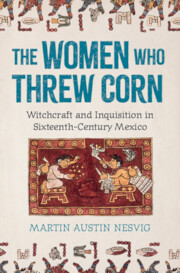Refine search
Actions for selected content:
584 results
From Cocaine to Avocados: Criminal Market Expansion and Violence
-
- Journal:
- International Organization , First View
- Published online by Cambridge University Press:
- 09 September 2025, pp. 1-39
-
- Article
-
- You have access
- Open access
- HTML
- Export citation
The Soft Guardrails of Legal Constitutionalism
-
- Journal:
- German Law Journal / Volume 26 / Issue 2 / March 2025
- Published online by Cambridge University Press:
- 01 September 2025, pp. 299-316
-
- Article
-
- You have access
- Open access
- HTML
- Export citation
22 - The United States from Independence to the war with Mexico, 1776–1848
-
-
- Book:
- The Cambridge History of War
- Published online:
- 18 July 2025
- Print publication:
- 14 August 2025, pp 530-551
-
- Chapter
- Export citation
Chapter 1 - “Lost in Translation”
-
-
- Book:
- Antifascism(s) in Latin America and the Caribbean
- Published online:
- 21 July 2025
- Print publication:
- 07 August 2025, pp 23-40
-
- Chapter
- Export citation
Chapter 16 - Translation and Adaptation
- from Part II - Theatre
-
-
- Book:
- María Irene Fornés In Context
- Published online:
- 27 August 2025
- Print publication:
- 07 August 2025, pp 171-180
-
- Chapter
- Export citation
Pathophysiology of penetrating captive-bolt stunning of horses
-
- Journal:
- Animal Welfare / Volume 34 / 2025
- Published online by Cambridge University Press:
- 25 July 2025, e51
-
- Article
-
- You have access
- Open access
- HTML
- Export citation
Legislator Responsiveness to Racialized Constituencies in Mexico
-
- Journal:
- Journal of Experimental Political Science , First View
- Published online by Cambridge University Press:
- 23 July 2025, pp. 1-13
-
- Article
-
- You have access
- Open access
- HTML
- Export citation
Longitudinal changes in income are associated with the healthiness and sustainability of foods purchased in Mexican households
-
- Journal:
- Public Health Nutrition / Volume 28 / Issue 1 / 2025
- Published online by Cambridge University Press:
- 17 July 2025, e126
-
- Article
-
- You have access
- Open access
- HTML
- Export citation
Female mayors and violence against women: evidence from Mexico
-
- Journal:
- Political Science Research and Methods , First View
- Published online by Cambridge University Press:
- 03 July 2025, pp. 1-8
-
- Article
-
- You have access
- Open access
- HTML
- Export citation
Chapter 5 - Whiteness and the US–Mexico Border
- from Part I - Whiteness and National Identity
-
-
- Book:
- Whiteness and American Literature
- Published online:
- 19 June 2025
- Print publication:
- 03 July 2025, pp 72-88
-
- Chapter
- Export citation
Diversity of Stomylotrema spp. in the Mexican tropical lowlands: the case of Stomylotrema bijugum and Stomylotrema vicarium (Digenea: Stomylotrematidae), parasites of aquatic and passerine birds
-
- Journal:
- Parasitology / Volume 152 / Issue 7 / June 2025
- Published online by Cambridge University Press:
- 03 July 2025, pp. 641-656
-
- Article
-
- You have access
- Open access
- HTML
- Export citation
Introduction
-
- Book:
- The Women Who Threw Corn
- Published online:
- 28 May 2025
- Print publication:
- 26 June 2025, pp 1-28
-
- Chapter
- Export citation
12 - Trade Protectionism and Integration in Latin America
-
-
- Book:
- Globalization in Latin America
- Published online:
- 09 June 2025
- Print publication:
- 26 June 2025, pp 255-289
-
- Chapter
-
- You have access
- Open access
- HTML
- Export citation
Decoding upgrading in middle-income countries: the political economy of IT industrial policy in two Mexican states
-
- Journal:
- Business and Politics , First View
- Published online by Cambridge University Press:
- 11 June 2025, pp. 1-24
-
- Article
-
- You have access
- Open access
- HTML
- Export citation

The Women Who Threw Corn
- Witchcraft and Inquisition in Sixteenth-Century Mexico
-
- Published online:
- 28 May 2025
- Print publication:
- 26 June 2025
Sticky industrial policies and divergent value chain upgrading patterns: lessons from Querétaro and Jalisco, Mexico
-
- Journal:
- Business and Politics , First View
- Published online by Cambridge University Press:
- 14 May 2025, pp. 1-22
-
- Article
-
- You have access
- Open access
- HTML
- Export citation
Chapter 11 - Romancing Latinidad
- from Part III - Time
-
-
- Book:
- Latinx Literature in Transition, 1848–1992
- Published online:
- 10 April 2025
- Print publication:
- 17 April 2025, pp 195-209
-
- Chapter
- Export citation
9 - A Corruption Lens on Atrocity Crimes
- from Part III - A Corruption Lens on Human Rights-Related Issues
-
- Book:
- Fighting Grand Corruption
- Published online:
- 03 April 2025
- Print publication:
- 10 April 2025, pp 182-201
-
- Chapter
- Export citation
Mineralogy of a cuspidine–hiortdahlite–wollastonite skarn associated with the Sierra La Vasca alkaline complex, Mexico
- Part of
-
- Journal:
- Mineralogical Magazine , FirstView
- Published online by Cambridge University Press:
- 10 April 2025, pp. 1-10
-
- Article
-
- You have access
- Open access
- HTML
- Export citation
5 - Fraud on the River
- from Part II - Putting Victims at the Center of Anti-Corruption Work
-
- Book:
- Fighting Grand Corruption
- Published online:
- 03 April 2025
- Print publication:
- 10 April 2025, pp 77-103
-
- Chapter
- Export citation
